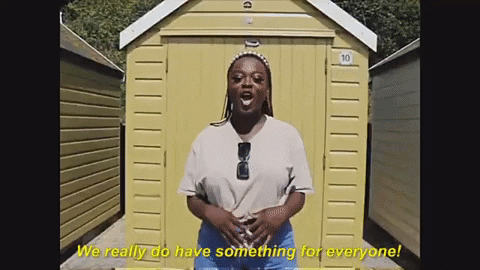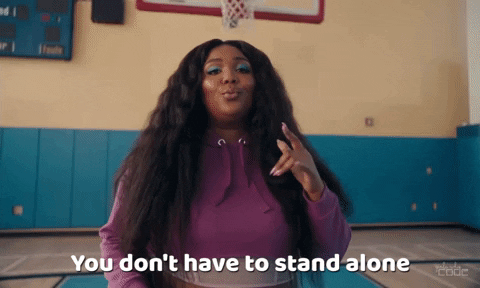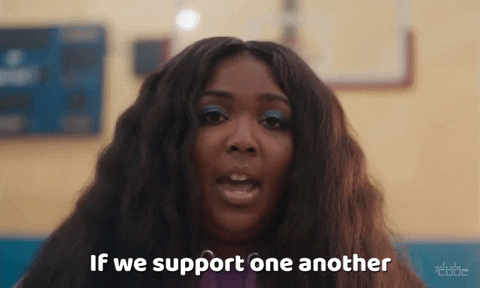Inclusive Design Practices You Should Implement As A UX Designer
As a budding UX designer, you are uniquely positioned to impact the world.

Editor’s Note: What’s up, Skillcrushers?! Desiree Cunningham here — your trusted content manager here at Skillcrush.
In the context of Black History Month, I’d like to highlight inclusive design and how it impacts our society. But first, let’s take a journey down the Inclusion lane.
The term inclusion as a philosophical practice is a product of the 1950s and 60s Civil Rights Movement, which fought against the rampant racism, discrimination, prejudice, inequality, and social injustice against Black Americans.
Black Americans’ struggle for social justice challenged institutionalized racism and segregation. And with the passing of pivotal court cases (like Brown v. Board of Education, Harper v. Virginia State Board of Elections, Loving v. Virginia, and Boynton v. Virginia) and legislation (like Civil Rights Act of 1957, Voting Rights Act of 1965), Black folks gained several civil liberties and highlighted social injustice in other groups marginalized by race, gender, sexuality, and ability.
The social justice movement continues with legislative and grassroots action and calls for diversity, equity, and inclusion initiatives.
Inclusion is the act or practice of including and accommodating people who have historically been excluded (because of their race, gender, sexuality, or ability) [Merriam-Webster].
The practice of inclusion acknowledges two truths.
- Disparity exists in the world. Inclusion-first principles require that we recognize groups that have been historically excluded and marginalized in society.
Divisive and exclusionary practices and behavior are not always explicit. It’s not always a racial slur yelled across a busy intersection or proud refusal to identify a person by their preferred pronouns. Such instances absolutely happen, and it’s abhorrent behavior; however, more often than not, exclusionary practices are covert.
Exclusionary practices look like microaggressions in the workplace. In a SurveyMonkey study, researchers found that 26% of respondents experienced microaggressions at work, 22% were undecided about their experience, and 36% witnessed microaggressions in their workplace.
Exclusionary practices also look like inaccessible websites. Web Content Accessibility Guidelines (WCAG) estimates that just 2% of websites across the internet are web accessible. TWO PERCENT OF ONE BILLION-PLUS WEBSITES!
And…
- We can fix this. When we solve a challenge that impacts at least one marginalized community, we create a more inclusive society for all human beings.
Everyone benefits from building accessibility measures like ramps. Everyone benefits from more readable websites. Everyone benefits from more welcoming workplaces.
We are all better off in an inclusive society. Liberties and concessions for a marginalized group, do not mean fewer rights for another. There’s more than enough to go around.
We are better as a society for acknowledging and including historically and presently marginalized people in all areas. And YOU can be a part of the change.
My intention with this editorial note has been to ground this introduction to inclusive design in the history and principles of inclusion, hard-fought and won by Black Americans. Happy Black History Month! – Desiree
As a budding user experience (UX) designer, you are uniquely positioned to impact the world in a big way… no pressure.
Read and implement the following four inclusive design practices.
Table of Contents

An Introduction to Inclusive Design

What Is Inclusive Design?
UX design is the process of creating human-centered products and services. The field is specifically concerned with solving pain points and removing barriers… so what is inclusive design and why should UXers practice it? Great question!
There are 7.4 billion on planet Earth. There are even fewer UX designers — the Bureau of Labor Statistics estimated 82,380 web and digital interface designers in 2021. That goes to show, fewer than 100,000 designers represent multiple billions of people. People with unique belief systems, sets of values, culture, education, and the list goes on. Because of this, every designer can involuntarily include or exclude an audience. Inclusive design is a checks and balance system that calls out our personal biases and corrects them.
Inclusive design is “design that considers the full range of human diversity with respect to ability, language, culture, gender, age and other forms of human difference,” according to the Inclusive Design Research Centre at OCAD University.
Inclusive Design Principles
Inclusive design operates under a handful of universal principles. They are as follows:
- Recognize exclusions. Identifying our exclusionary practices is not a cut-and-dry process. I’m sure if many of us knew that we were excluding people, we’d attempt to fix it. The fact is most people don’t set out to exclude others. However, it is up to designers to seek resources, tools, and different perspectives to identify biases in their work.
- Learn from diversity. Inclusive thinking is not a one-and-done deal. As technology and society evolve, we learn more about one another and how different identities connect within a society. Designers must stay abreast of ongoing paradigm changes and shifts.
- Provide equivalent user experiences to all people. The main tenant of inclusive design is that design is accessible to ALL people. Everyone can benefit from inclusive design practices, so UX professionals should create designs with marginalized groups in mind.
Why Does Inclusive Design Matter?
Let’s return to the role of UX designers: to create human-centered design solutions. Designers capture the human experience, not some experience — ALL human experiences. Some humans experience color blindness, some have bachelor’s degrees, some never left their home state, some experience food insecurity, and some were raised in a religious household. These unique experiences are valid and valuable for UX designers to consider as they determine how to best solve users’ pain points and barriers.

Four Ways to Implement Inclusive Design as a UX Designer
1. Take a Hard Look At Your Team

Inclusive design starts before you even begin the inclusive design process.
Groups with diverse perspectives often outperform groups of the “best and brightest” in innovation, according to Scott Page, professor of complex systems and author of “The Difference.” The abundance of lived experience and perspectives informs our knowledge of a subject. For this reason, inclusive design must start with the human diversity of your design team.
“Diversity can provide insurance, improve productivity, spur innovation, enhance robustness, produce collective knowledge, and, perhaps most important in light of these other effects, sustain further diversity.” ~ Scott Page, Diversity and Complexity
A commitment to Diversity, Equity, and Inclusion (DEI) provides an important framework for many institutions. Yet, the focus can over-emphasize the D at the expense of the E and I; for example, “the board of directors is diverse.” “We have female representation in the office.”
Diversity is not enough.
Inclusion is a verb — a call to action. Diversity is a noun — a state of being.
As you build a diverse design team, ensure those folks are included in the conversation and their ideas are heard, understood, and considered.
Make no mistake. We understand that creating diverse teams is a complex undertaking given the tech industry’s culture and demographics historically.
According to CompTIA,
- African American and Black folk make up 8% of the tech workforce, compared to 12% of the entire workforce.
- The Hispanic and Latino community account for 8% of tech employees, compared to 16% of all occupations.
- Women account for 26% of the tech industry, compared to 49% of all occupations.
Online coding schools like Skillcrush and organizations like Blacks in Technology are closing the gap. However, until the tech industry reflects the demographics of the entire workforce, a good mantra is “nothing about us without us.”
Ask yourself the questions:
- What perspective do I bring to the table?
- What do my teammates contribute?
- Who is left out?
- What resources are available that can close the gap?
If resource limitations restrict your hiring capabilities, seek the guidance and perspective of advocacy groups identified as not present in your group or hire a consultant.
2. Consider Visual Representation
Who is represented in your illustrations, graphics, and images? Who isn’t represented? Why?
“Narratives not only afford a special kind of emotional proceeding that allows us to both reflect on and react to various storylines, but they convey complicit cultural value,” according to social psychologist Dara Greenwood for Psychology Today. “These characters and their lives matter. The need to see ourselves reflected on the screen is also an outgrowth of the need to be seen and valued in everyday life.”
Visual design is a complementary discipline to UX design. While UX designers are not professionals drawing illustrations, shooting photography, and plotting logos, UXers DO have a stake in the visual design process.
UX researchers and designers conduct UX research that defines the user’s problem. That same research can also inform designers and stakeholders about their audience and how they can best represent them.
Before reaching for the same handful of stock images, ask yourself:
- Who is my audience?
- How old are they?
- What do they look like?
- Do they have disabilities?
- Who have I left out?
Seeing oneself reflected in the media you consume is impactful.
3. Adopt An Accessibility-First Mindset
At Skillcrush, we assert that UX design that isn’t accessible is not UX design… it’s also not inclusive. Here’s the deal: web accessibility practices ensure that people with disabilities — auditory, cognitive, neurological, physical, speech, and visual — can access information on the internet.
Here’s our list of quick accessibility practices that you can make now:
- Check your design color contrast, using the WebAim or Level Access color contrast checker.
- Ensure your design’s colors are color blind-friendly with the Sim Daltonism app.
- Add alt text to images and confirm hyperlinks have appropriate color contrast.
- Test your accessible design with assistive technology like screen readers
4. Readability > Aesthetics

Let’s talk about typography. Typography is the art of arranging type, but in the case of inclusion, it often determines who can and can not access information. Sure, you can design a swanky and visually appealing typescale that few people can read. But would that be UX design? (Hint: Refer back to our talk on web accessibility.) NO!
It’s a UXer’s primary duty to improve the usability of products, and in this case, digital products like websites. Readability may seem like a negligible aspect, however, it makes a world of difference to those with any level of vision loss as well as readers with full vision.
Make your typography readable with these tips:
- Select a readable font
- Consider the background color behind your text
- Choose a font color with high contrast
Each and every one of us has the power to recognize our personal bias and create more inclusive spaces and a better society. And we can do this TOGETHER! If you think your impact is best served in the design field, join our free coding bootcamp Camp Skillcrush to start your journey into tech. We’ll be with you every step of your journey as, together, we diversify the tech industry and create a more inclusive society. We’ll see you there! From Skillcrush, the coding school with a ❤️.
Desiree Cunningham
Category: Blog, UI/UX Designer, User Experience Design, Web Designer






